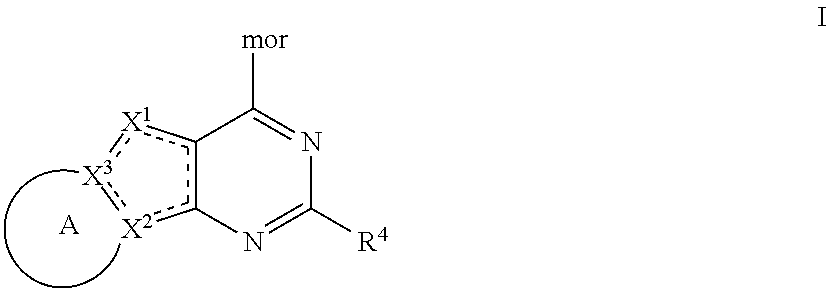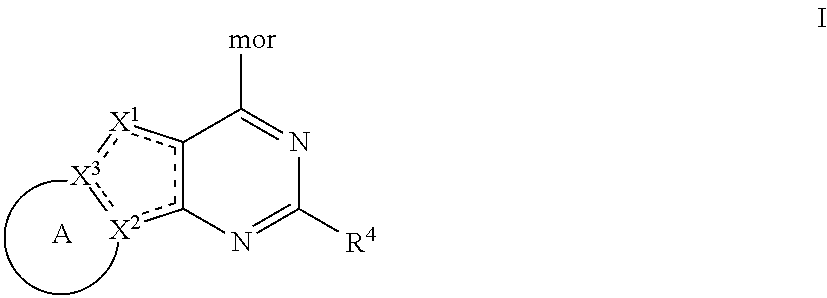Tricyclic PI3K inhibitor compounds and methods of use
a technology of pi3k inhibitors and compounds, applied in the field of tricyclics, can solve the problem of high frequency of therapeutic failures and achieve the effect of reducing the number of side effects and reducing the risk of side effects
- Summary
- Abstract
- Description
- Claims
- Application Information
AI Technical Summary
Benefits of technology
Problems solved by technology
Method used
Image
Examples
example 1
2,6-dichloro-9-methyl-9H-purine 4
[0215]
[0216]The cyano group of 5-amino-1-methyl-1H-imidazole-4-carbonitrile 1 is hydrolyzed to the amide in sulfuric acid to give 5-amino-1-methyl-1H-imidazole-4-carboxamide 2 which was cyclized with urea to 9-methyl-1H-purine-2,6(3H,9H)-dione 3. Chlorination of 3 yields 2,6-dichloro-9-methyl-9H-purine 4.
example 2
4-(4,4,5,5-tetramethyl-[1,3,2]dioxaborolan-2-yl)-1H-indazole 24—route 1
[0217]
[0218]To a solution of 3-bromo-2-methyl aniline (5.0 g, 26.9 mmol) in chloroform (50 mL) was added potassium acetate (1.05 eq., 28.2 mmol, 2.77 g). Acetic anhydride (2.0 eq., 53.7 mmol, 5.07 mL) was added with concurrent cooling in ice-water. The mixture was then stirred at room temperature for 10 minutes after which time a white gelatinous solid formed. 18-Crown-6 (0.2 eq., 5.37 mmol, 1.42 g) was added followed by iso-amyl nitrite (2.2 eq., 59.1 mmol, 7.94 mL) and the mixture was heated under reflux for 18 h. The reaction mixture was allowed to cool, and was partitioned between chloroform (3×100 mL) and saturated aqueous sodium hydrogen carbonate (100 mL). The combined organic extracts were washed with brine (100 mL), separated and dried (MgSO4). The crude product was evaporated onto silica and purified by chromatography eluting with 20% to 40% EtOAc-petrol to give 1-(4-bromo-indazol-1-yl)-ethanone A (3.14...
example 3
4-(4,4,5,5-Tetramethyl-[1,3,2]dioxaborolan-2-yl)-1H-indazole 24—route 2
[0221]
[0222]To a solution of 2-methyl-3-nitroaniline (2.27 g, 14.91 mmol) in acetic acid (60 mL) was added a solution of sodium nitrite (1.13 g, 1.1 eq.) in water (5 mL). After 2 h, the deep red solution was poured onto ice / water and the resulting precipitate collected by filtration to yield 4-nitro-1H-indazole C (1.98 g, 81%).
[0223]A mixture of 4-nitro-1H-indazole C (760 mg, 4.68 mmol), palladium on charcoal (10%, cat.) and ethanol (30 mL) was stirred under a balloon of hydrogen for 4 h. The reaction mixture was then filtered through celite, and the solvent removed in vacuo to yield 1H-indazol-4-ylamine D (631 mg, 100%).
[0224]An aqueous solution of sodium nitrite (337 mg, 4.89 mmol) in water (2 mL) was added dropwise to a suspension of 1H-indazol-4-ylamine D (631 mg, 4.74 mmol) in 6M hydrochloric acid (7.2 mL) at below 0° C. After stirring for 30 minutes, sodium tetrafluoroborate (724 mg) was added to the reacti...
PUM
| Property | Measurement | Unit |
|---|---|---|
| pH | aaaaa | aaaaa |
| weight:weight | aaaaa | aaaaa |
| particle sizes | aaaaa | aaaaa |
Abstract
Description
Claims
Application Information
 Login to View More
Login to View More - R&D
- Intellectual Property
- Life Sciences
- Materials
- Tech Scout
- Unparalleled Data Quality
- Higher Quality Content
- 60% Fewer Hallucinations
Browse by: Latest US Patents, China's latest patents, Technical Efficacy Thesaurus, Application Domain, Technology Topic, Popular Technical Reports.
© 2025 PatSnap. All rights reserved.Legal|Privacy policy|Modern Slavery Act Transparency Statement|Sitemap|About US| Contact US: help@patsnap.com



